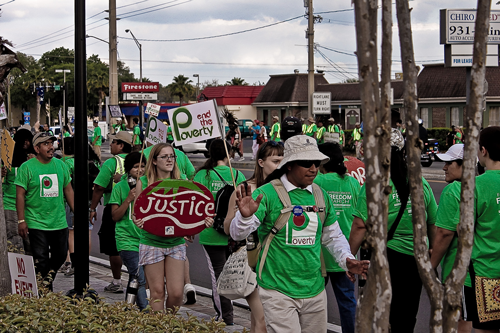ADVOCACY
Advocacy strategies are not easily divisible from community organizing, especially within the context of human rights and racial justice. When communities advocate on their own behalf, they can achieve tremendous social change.
Examples from the USHRF’s 2011 convening include:
1. Racial Profiling
The Rights Working Group (RWG) campaign against racial profiling offers a useful case study of advocacy in response to a racial justice issue that has stubbornly persisted throughout history. The coalition unites multiple constituencies embattled by racial profiling to pass the End Racial Profiling Act (ERPA), which would prohibit federal, state, and local law enforcement agencies from engaging in profiling on the basis of race, religion, ethnicity, and national origin. This campaign illustrates the convergence of multiple facets of human rights advocacy:
- Leadership comes from communities that bear the brunt of racial profiling.
- Testimonies from directly affected individuals have served as an important advocacy tool.
- Local and state advocacy can/should be undertaken concurrently with federal advocacy. RWG pushes for adoption of local ordinances and state legislation that include language and provisions from federal legislation.
- RWG frames racial profiling as a severe violation of civil rights, as well as a violation of international human rights treaties that the U.S. has ratified and signed, namely, the ICERD and ICCPR.
- RWG engaged international human rights mechanisms by submitting a shadow report on racial profiling to the UN Human Rights Council as part of the U.S.’ Universal Periodic Review process.
2. Human Rights at Home Campaign
The Human Rights at Home (HuRAH)’s campaign coalesces 50+ organizations in a cross-cutting movement calling for improved mechanisms to enhance federal, state, and local government accountability to human rights standards. HuRAH provides a clear example of how multiple advocacy strategies can be creatively applied when conducting a national campaign. Through engagement with multiple constituencies, including government officials, across a range of coordinated policy, education, and outreach efforts, Campaign members have learned that:
- It is critical to undertake field-building in conjunction with policy advocacy activities because it engages a large number of stakeholders in developing the vision and goals of the Campaign. Having an active and robust human rights constituency is essential for achieving legislative change.
3. Human Rights Documentation
The strategy of human rights documentation deeply engages impacted communities by empowering members to expose abuses and educate elected and appointed government officials about the human impact of flawed policies.
Community Asset Development Re-defining Education (CADRE) in Los Angeles organizes parents to challenge Los Angeles County Unified School District's (LAUSD) disciplinary procedures that have sent countless African American and Latino youth down a school to prison pipeline.
CADRE parents went door to door in South Los Angeles neighborhoods, interviewing families and collecting stories about the effect of school suspensions on their children's right to education and dignity. This participatory human rights documentation project resulted in a report on school push-out and a hearing, in which parents and students gave testimonies to a panel including a LAUSD Board of Education member. Human rights documentation proved to be a powerful tool in generating media attention and pressure on the school board, as well as attracting new parent members to join CADRE's efforts.
 The Coalition of Immokalee Workers (CIW) protests against Publix Supermarkets in Tampa, Florida. Credit: Flickr user GwMc
The Coalition of Immokalee Workers (CIW) protests against Publix Supermarkets in Tampa, Florida. Credit: Flickr user GwMc
Such documentation was effective because:
- Personal stories captured the attention of board members who were previously disengaged at meetings.
- People better trust peers (rather than distant "experts") and are more likely to share their experiences and stories with those who have endured similar concerns.
- Participatory documentation elevated the credibility and influence of parents' testimony.
- For more examples of successful participatory human rights documentation, see United Workers, the Coalition of Immokalee Workers, and the Border Network for Human Rights.
4. Global Exchanges: Partnering with International Organizations
Global exchanges among advocates addressing parallel human rights issues enables fruitful connectivity, collaboration, and strategy-sharing. For example:
- S'bu Zikode, president of the South African organization Abahlali baseMjondolo (a.k.a. Shackdwellers' Movement), toured the U.S. in 2010. He met with four member organizations of the Campaign to Restore National Housing Rights during his trip, spoke at relevant events, and exchanged ideas and insights with a variety of advocacy groups across the country.
- The National Economic and Social Rights Initiative helped facilitate partnerships, exchanges, and solidarity between those activists who survived Hurricane Katrina and the Asian tsunami. They shared best practices and strategies with one another for post-disaster rebuilding rooted in community participation and human rights principles.


